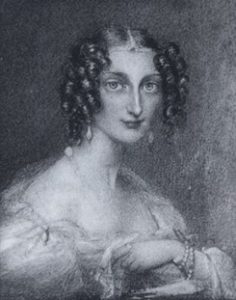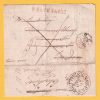It’s not often I come across so damn interesting, but this is one of those times
I bought a box lot of GB pre stamp letter fronts and entires in 2004 and was blown away by what I found among them. 9 letters written by the Duke of Somerset to Miss Elizabeth Law, written between March and December 1832.
A little bit about the parties in the letters
The Duke of Somerset (1775 – 1855)

Edward Adolphous St Maur, 11th Duke of Somerset was born with the surname Seymour, but it was later changed to St Maur. In 1808 he purchased a London townhouse at 40 Park Lane (corner of Park Lane and Oxford Street, opposite Marble Arch) which he named Somerset House, and where he spent much of his time (the house was demolished in 1915). In 1829 he purchased from George Templer (1781–1843) the Devonshire estate of Stover in the parish of Teigngrace, near Newton Abbot, and made Stover House his principal residence, where he displayed the valuable “Hamilton” art collection. These are the 2 addresses from which the letters appear to have been sent.
He was President of the Royal Institution, a Fellow of the Royal Society, and was made a Knight of the Garter by Queen Victoria. He also had the title Vice-Admiral of Somerset bestowed upon him, and was the last recipient of such an honour.
More info can be found here
https://en.wikipedia.org/wiki/Edward_St_Maur,_11th_Duke_of_Somerset
The Honourable Miss Elizabeth LAW (1799 – 1883)

Some of the address offer clues as to who Miss Law was, in particular 3 Stratford Place. The site is currently the Tanzania High Commission, but in the 1830’s it was the home of Lord and Lady Ellenborough. Lady Ellenborough was born Anne Towry, and married Edward Law, 1st Baron Ellenborough in 1790. She had 5 children, her 2nd child Elizabeth Susan Law was born 6 Sep 1799, married Charles Abboyt, 2nd Baron Colchester in 1836.
The Law family were very prominent in British politics and public life, with her father being Lord Ellenborough (Lord Chief Justice and Chancellor of the Exchequer at various periods of his service), MP’s, lawyers and clergy among her recent ancestry. Elizabeth’s uncle, Thomas Law married Eliza Parke Custis who was the granddaughter of Martha Washington. Another address in the correspondence is 3 Sion Hill, Tunbridge Wells, which is the marital home of her younger sister, Frances.
Her husband, Charles Abbot 2nd Baron Colchester (1798 – 1867) was a man with a wealth of history and influence in both military and political life, having attained the rank of Rear Admiral, then Vice-Admiral, and finally Admiral in 1864. He also served as Paymaster General, Postmaster General, and was a Privy Councillor from 1852.
More info can be found here
https://en.wikipedia.org/wiki/Charles_Abbot,_2nd_Baron_Colchester
Now some details about the letters.





They go from the mundane to the utterly fascinating, and they certainly shine a light on pre-Victorian life for the wealthy and connected, which is clearly far-detached from the everyday man in the street, where poverty, disease and poor health were a daily battle.
Letter 1
Dated 25 March 1832, sent from Park Lane and addressed to 3 Stratford Place, no postal markings but has a complete wax seal on reverse with the Duke’s insignia “Crown over S”. The letter appears to be written by the Duke’s assistant, thanking Miss Law for a book she sent him about the “practical terms and abbreviations of the Italian language”.
Letter 2
Dated 19 May 1832, addressed to 3 Stratford Place, as letter 1. This letter is also written by the Duke’s assistant, and talks about a pamphlet that she sent him, detailing “principles issued by a Minister of State”. The Duke has sent the pamphlet back to her – “The Duke returns the pamphlet, as he does not believe Miss Law meant to give it to him. Indeed such a present would have looked as if she wished to corrupt his political principles, an intention which he is sure is the furthest from her thoughts”. If only I had the pamphlet , what on Earth was in it?!
Letter 3
Dated 28 June 1832, sent from Park Lane and addressed to “The Honourable Miss Elizabeth Law” addressed to 3 Stratford Place, as letter 1.
This letter is written by the Duke, and meanders on to a lot of topics surrounding a book that he is writing. He is also providing some tourist information, as Miss Law is going to Yorkshire – “At Knaresborough is a petrifying spring which apparently turns to stone almost everything that is placed beneath it”. I hope not!
Letter 4
Dated 30 August 1832 from Putney, addressed as like a “Free” letter, but not taken as such. Boxed “TP Wimbledon” 2 line in red, “To Pay 2d Only” and manuscript “2” on front. Reverse has “Night AUG 30 1832” and receiver’s mark of same date. Addressed to Miss Law, C/- Charles Des Voeux, Pembury, Tunbridge. (Charles Des Voeux, the son of Charles the 2nd Baronet of Indiaville, was married to Elizabeth’s youngest sister, Frances Henrietta Law in 1832, but died the following year in Belgium aged just 31). Signed “Somerset” bottom left as per Free front. Wax seal on reverse complete.
This letter is a short written extract “from Mrs Wise’s letter of 23rd August 1832”, which is concerned with the differences between the English and the French, particularly how the English experience to expand their mind, whilst the French experience to derive pleasure and enjoyment
Letter 5
Dated 10 September 1832 from Putney, addressed as like a “Free” letter, but not taken as such. Boxed “TP Wimbledon” 2 line in red, “To Pay 2d Only” and manuscript “2” on front. Reverse has “Night SEP 10 1832” and receiver’s mark of same date. Addressed to Miss Law, 3 Sion Hill, Tunbridge Wells. Signed “Somerset” bottom left as per Free front. Wax seal on reverse complete.
This letter is written by the Duke, and is a short literary discussion, talking about “Satires” by 2nd Century poet Juvenal, and whether it is considered appropriate for a lady to peruse it. He also has an extract from an article about an Italian translation of Florian’s Ode
Letter 6
Dated 29 October 1832 from Newton Abbot. Addressed to Miss Law, 3 Sion Hill, Tunbridge Wells. “FREE OCT 31 1832” in red on face, with “NEWTON ABBOT OC 29 1832” CDS on reverse. Signed “Somerset” bottom left as per Free front. Wax seal on reverse complete.
This letter is politically interesting to say the least. The Duke recounts a story about a meeting in Edinburgh after the death of Mr Fox (Charles James Fox, MP from 1768-1806, and Foreign Secretary in 1806), where they seeked to celebrate the event, and asked Sir Walter Scott to sing a song. The Duke starts by saying that “Sir Walter Scott was an instance of a very fine understanding connected with a despicable character”, then goes on –
“They wanted a song of triumph, and the applied to Sir Walter Scott. Uniting meanness with bad taste, he furnished them with a song suitable to politicians and to hunters, as if Mr Fox had not only been an obnoxious statesman, but might be represented in the character of the animal that bears his name”
He finishes the letter by stating that he was never a friend of Mr Fox, nor had any dealings or private conversations with him – “I admired his abilities but never liked his character, and more than suspected his honesty”.
A fantastic political insight into events of the time, from someone who was there in those hallowed halls
Letter 7
Dated 10 November 1832 from Newton Abbot. Addressed to Miss Law, 3 Sion Hill, Tunbridge Wells. “FREE NO 12 1832” in red on face, with “NEWTON ABBOT NO 10 1832” CDS x2 on reverse. Signed “Somerset” bottom left as per Free front. Wax seal on reverse complete.
The Duke writes hoping Miss Law’s mother Lady Ellenborough is feeling better. He then goes on to talk about poetry, as Elizabeth is talking about learning Latin, and finally mathematics! He then talks about a French book “L’âme des bêtes”, or The Soul of the Beasts, which according to the Duke where you “attribute to beasts an origin that you ascribe to men, it supposes them to be an incarnation of evil spirits”
He finishes the letter to say all is well, except for the chapel which is not yet licensed, “The Bishop of Exeter is so tedious and so difficult”.
Letter 8
Dated 24 November 1832 from Newton Abbot. Addressed to Miss Law, 3 Stratford Place, London. “FREE NO 26 1832” in red on face, with “NEWTON ABBOT NO 24 1832” CDS x2 on reverse. Signed “Somerset” bottom left as per Free front. Wax seal on reverse complete.
A letter and a written extract in this outer. The extract is titled “Extract from (Lorenzo) Pignotti’s dissertation on the origin of Italian”.
The letter once again talks about Lady Ellenborough’s illness, however he does say “I think she has, in Mr Pennington, a very judicious medical attendant”. He then goes on to talk once again about poetry and Miss Law learning Latin, and suggests that she has “the organ of language in an eminent degree”
Letter 9
Dated 25 December 1832 from Newton Abbot. Addressed to Miss Law, 3 Stratford Place, London. “FREE DE 25 1832” in red on face, with “NEWTON ABBOT DE 25 1832” CDS x2 on reverse. Signed “Somerset” bottom left as per Free front. Wax seal on reverse complete.
A letter and an insert in this outer. The extract is titled “An extract from the Edinburgh Gazette, Vol 23 page 231”, which is discussion on literature and “moral philosophy”.
The letter is from the Duke to Miss Law. He talks about memory and enquiry, how one helps the other. It appears that Miss Law is a collector of postal history, as he closes the letter by saying he is “unable to procure a frank of the Duke of Hamilton, for I do not believe that my daughters correspond with the Duchess”, franks being fronts of free letters signed by the Duke. He goes on to say “they receive letters from Lady Lincoln, but these will no longer be signed by the Duke”. Interesting, I have something in common with Miss Law!






